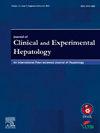Validation of a Multiplex Hypermethylation-based Blood Test to Detect Hepatocellular Carcinoma: A Prospective Case-control Study
IF 3.2
Q2 GASTROENTEROLOGY & HEPATOLOGY
Journal of Clinical and Experimental Hepatology
Pub Date : 2025-04-12
DOI:10.1016/j.jceh.2025.102578
引用次数: 0
Abstract
Background/Aims
This study aimed to evaluate the performance of an investigational multiplex hypermethylation-based HCC screening test (mhsH) in the detection of hepatocellular carcinoma (HCC) using blood samples.
Methods
Adult patients with chronic liver disease (CLD) were enrolled in this prospective case-control study. For the mhsH test, blood samples were collected, and the cell-free DNA obtained from the samples was analyzed for methylation patterns using multiplex droplet digital polymerase chain reaction. The performance of the mhsH test for the detection of HCC was evaluated according to sensitivity, specificity, positive predictive value (PPV), negative predictive value (NPV), and area under the receiver operating characteristic curve and a comparative analysis with alpha-fetoprotein (AFP) was performed. Radiological imaging was used as the clinical reference standard.
Results
A total of 649 participants were screened for recruitment, and the mhsH test performance assessment was carried out for 588 patients with complete local data, comprising 142 patients in the HCC group and 446 in the non-HCC CLD control group. The test demonstrated robust HCC signal detection, achieving an AUC of 0.91 (95% confidence interval [CI]: 0.88-0.94). The sensitivity and specificity were 0.91 (0.85-0.95) and 0.88 (0.85-0.91), with PPV and NPV of 0.71 (0.66-0.76) and 0.97 (0.95-0.98), respectively. The sensitivity of early-stage, intermediate-stage, and late-stage (Barcelona Clinic Liver Cancer) was 0.87 (73-0.96), 0.91 (0.77-0.98), and 0.94 (0.82-0.99), respectively. The test correctly identified 57 of 62 (92%) patients with AFP-negative HCC. Combining AFP with the mhsH test increased sensitivity to 0.96 (0.92-0.99).
Conclusion
The mhsH test demonstrated high accuracy for detecting HCC signals. Furthermore, when combined with AFP, the test performance for detecting HCC in patients with CLD has significantly improved.

多重高甲基化血液检测检测肝细胞癌的验证:一项前瞻性病例对照研究
背景/目的本研究旨在评估研究性基于多重高甲基化的HCC筛查试验(mhsH)在使用血液样本检测肝细胞癌(HCC)中的表现。方法成人慢性肝病(CLD)患者纳入前瞻性病例对照研究。对于mhsH测试,采集血液样本,并使用多重液滴数字聚合酶链反应分析从样本中获得的无细胞DNA的甲基化模式。根据敏感性、特异性、阳性预测值(PPV)、阴性预测值(NPV)、受者工作特征曲线下面积评价mhsH检测HCC的性能,并与甲胎蛋白(AFP)进行对比分析。影像学检查作为临床参考标准。结果共筛选入组649例,对588例本地数据完整的患者进行了mhsH测试性能评估,其中HCC组142例,非HCC CLD对照组446例。该测试显示出强大的HCC信号检测,AUC为0.91(95%可信区间[CI]: 0.88-0.94)。敏感性和特异性分别为0.91(0.85 ~ 0.95)和0.88 (0.85 ~ 0.91),PPV和NPV分别为0.71(0.66 ~ 0.76)和0.97(0.95 ~ 0.98)。早期、中期、晚期(巴塞罗那临床肝癌)的敏感性分别为0.87(73 ~ 0.96)、0.91(0.77 ~ 0.98)、0.94(0.82 ~ 0.99)。在62例(92%)afp阴性HCC患者中,该检测可正确识别57例。AFP联合mhsH检测灵敏度为0.96(0.92-0.99)。结论mhsH检测肝癌信号具有较高的准确性。此外,当联合AFP时,检测CLD患者HCC的测试性能明显提高。
本文章由计算机程序翻译,如有差异,请以英文原文为准。
求助全文
约1分钟内获得全文
求助全文
来源期刊

Journal of Clinical and Experimental Hepatology
GASTROENTEROLOGY & HEPATOLOGY-
CiteScore
4.90
自引率
16.70%
发文量
537
审稿时长
64 days
 求助内容:
求助内容: 应助结果提醒方式:
应助结果提醒方式:


